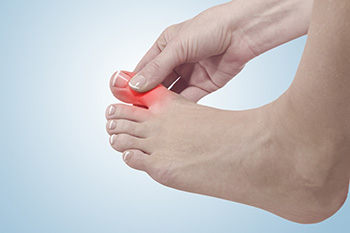
Bunions and gout are two common conditions that can cause pain and discomfort of the big toe, but they have different causes and symptoms. A bunion is a bony bump that forms at the base of the big toe due to misalignment of the toe joint. It is often caused by genetics, wearing ill-fitting footwear, or an imbalance in foot mechanics. Symptoms include pain, swelling, and redness surrounding the big toe joint, which can make walking difficult. Gout, on the other hand, is a form of arthritis caused by the buildup of uric acid crystals in the joints, often affecting the big toe. Gout typically causes sudden intense pain, swelling, and redness, often triggered by dietary factors or dehydration. Treatment for bunions may include wearing proper shoes, using orthotics, or, in severe cases, surgery. Gout can be managed with medication to reduce inflammation and dietary changes. A podiatrist can provide personalized care for both conditions, offering relief and recommending lifestyle adjustments. If you are experiencing foot pain, it is suggested that you schedule an appointment with a podiatrist.
If you are suffering from bunion pain, contact Philip Hahn, DPM of Advanced Foot & Ankle Center. Our doctor can provide the care you need to keep you pain-free and on your feet.
What Is a Bunion?
Bunions are painful bony bumps that usually develop on the inside of the foot at the joint of the big toe. As the deformity increases over time, it may become painful to walk and wear shoes. Women are more likely to exacerbate existing bunions since they often wear tight, narrow shoes that shift their toes together. Bunion pain can be relieved by wearing wider shoes with enough room for the toes.
Causes
- Genetics – some people inherit feet that are more prone to bunion development
- Inflammatory Conditions - rheumatoid arthritis and polio may cause bunion development
Symptoms
- Redness and inflammation
- Pain and tenderness
- Callus or corns on the bump
- Restricted motion in the big toe
In order to diagnose your bunion, your podiatrist may ask about your medical history, symptoms, and general health. Your doctor might also order an x-ray to take a closer look at your feet. Nonsurgical treatment options include orthotics, padding, icing, changes in footwear, and medication. If nonsurgical treatments don’t alleviate your bunion pain, surgery may be necessary.
If you have any questions, please feel free to contact our office located in Texarkana, TX . We offer the newest diagnostic and treatment technologies for all your foot care needs.




